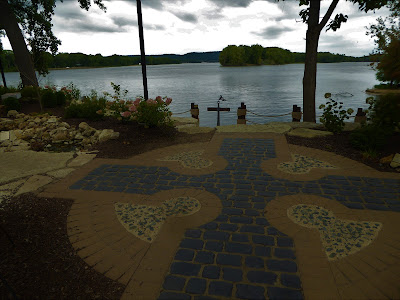Driving across the Middle
Mississippi River's back waters
We headed to Goose Island in the backwater of the Mississippi River. Yes, they have large mosquitos but turned out to be a nice and interesting area near La Crosse, WI for a short time.
La Crosse has been on our radar since reading about their trails and bike riding. Besides, we were driving right through the area.
Goose Island turned out to be a very large and lovely campground with large spaces. We enjoyed our walks along the river and learned about people taking their boats out to sandbars to camp. One fellow has a camper shell on his pontoon for protection from the elements and bugs while camping on the Mississippi sandbars.

Lock & Dam #7 is one of the most visited lock and dam structures on the Mississippi River and lies in the rolling Upper Mississippi River Valley near La Crescent, MN and La Crosse, WI.
This lock is located at one of the most scenic spots on the Great River Road. The river is miles wide at this point, with many islands. The locks and the main dam control structure are located on the Minnesota side of the river.
All types of vessels use the lock during the navigation season, which extends from mid-March through mid-December. The lock provides a vertical lift of 8 feet for boats, ranging from canoes to large towboats with barges. The Upper Mississippi River serves as a main artery for Midwest grain bound for both domestic and international markets. More than 15 millions tons of cargo pass through the lock each year with farm products, chemicals and coal the major commodities. Also, more than 13,000 recreational craft use the lock annually.
Pool 7 which is the lake created upstream from the dam, forms a valuable upstream environmental habitat and resource for migrating waterfowl. Sand bars along the channel offer opportunities for recreation.
We watched as the tugboat maneuvered the barges that were tied together into the lock very slowly with only inches to spare on each side. Half of the barges were released and the tugboat pulled the last half back out since there was not enough room for all of them. The first half was lifted and then the second half sent though and then the two halves rejoined. It was quite a slow process.
This 24-mile trail travels through prairies and backwaters of the upper Mississippi River valley. Built on an abandoned Chicago-Northwestern railroad line, the trail has a finely crushed limestone surface suitable for walking and bicycling for much of the year and snowmobiling, cross-country skiing and snowshoeing in winter. The Great River trail is within a larger area called the Mississippi Flyway and passes through two National Wildlife Refuges.
There are several Rails to Trails that run along the rivers and marshes around La Crosse. The first day was a quiet, long and mostly straight trail. We paid our $5 for the trail pass before our ride.
La Crosse's Friendship Gardens
We enjoyed the beauty of the Riverside International Friendship Gardens. This collection of public gardens celebrates La Crosse’s sister-city relationships with communities in China, Germany, France, Russia, Norway and Ireland.
Flying Goose
There is a lot of open space with corn, soybeans and sunflowers as we drove through the Midwest. We stopped at Flying Goose Campground but decided to forego seeing the Spam Museum.
Our morning walk as the sun was coming up.
Our next stop was in Mitchell, SD and the Corn Palace.
The Palace is redecorated each year with naturally colored corn and other grains and native grasses to make it “the agricultural show-place of the world”. They use 13 different colors or shades of corn to decorate the Corn Palace: red, brown, black, blue, white, orange, calico, yellow and now green corn! A different theme is chosen each year, and murals are designed to reflect that theme. Ear by ear the corn is nailed to the Corn Palace to create a scene. The decorating process usually starts in late May with the removal of the rye and dock. The corn murals are stripped at the end of August and the new ones are completed by the first of October. Looks like we made it in the nick of time.
The 50-foot-tall statue depicting a young Native American woman with a star quilt is made entirely of stainless steel and weighs about 50 tons was built along the banks of the Missouri River.
We made across those states and pulled out our hiking boots in Western South Dakota.


























